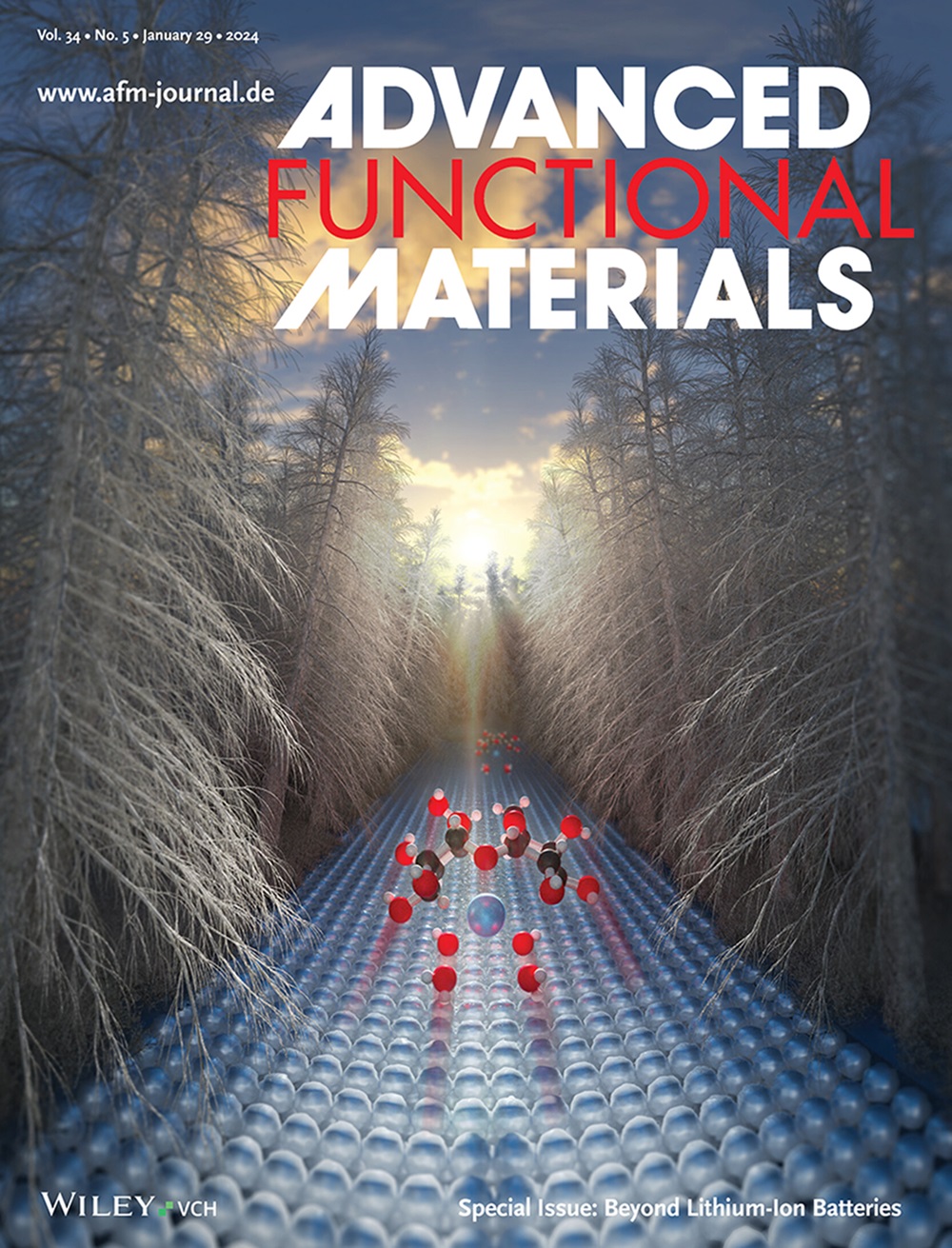CO2‐Mediated Dynamic Site Modulation in Copper Catalysts for Selective Electrocatalytic Nitrite‐to‐Ammonia Conversion
IF 19
1区 材料科学
Q1 CHEMISTRY, MULTIDISCIPLINARY
Liyao Gao, Hao Sun, Yizhe Li, Haoran Sun, Haoyang Wu, Longtao Ren, Qingzheng Xu, Jitao Chen, Man Zhao, Wen Liu
求助PDF
{"title":"CO2‐Mediated Dynamic Site Modulation in Copper Catalysts for Selective Electrocatalytic Nitrite‐to‐Ammonia Conversion","authors":"Liyao Gao, Hao Sun, Yizhe Li, Haoran Sun, Haoyang Wu, Longtao Ren, Qingzheng Xu, Jitao Chen, Man Zhao, Wen Liu","doi":"10.1002/adfm.202512473","DOIUrl":null,"url":null,"abstract":"The rational modulation of catalytic sites to steer multi‐step reaction pathways remains pivotal yet challenging in electrochemical ammonia synthesis. Herein, by investigating three representative copper configurations—single atom (Cu–N<jats:sub>4</jats:sub>), cluster embedded (Cu–N<jats:sub>4</jats:sub>/Cu<jats:sub>x</jats:sub>), and nanoparticle (Cu–NPs)—how CO<jats:sub>2</jats:sub> chemisorption differentially engineers active sites to optimize nitrite‐to‐ammonia conversion is unraveled. Systematic evaluations demonstrate CO<jats:sub>2</jats:sub>’s tripartite role: 1) Stabilizing <jats:sup>*</jats:sup>NOOH intermediates through electronic modulation (Bader charge analysis), 2) Suppressing hydrogen evolution via site‐specific blocking (<jats:sup>*</jats:sup>COO⁻ on Cu–N<jats:sub>4</jats:sub>, <jats:sup>*</jats:sup>CO on Cu–NPs; in situ Raman), and 3) Reducing the NO<jats:sub>2</jats:sub> → NOOH barrier on Cu–NPs (ΔG‡ = 0.34 eV by DFT). The synergistic Cu–N<jats:sub>4</jats:sub>/Cu<jats:sub>x</jats:sub> configuration achieves 94.5% NH<jats:sub>3</jats:sub> Faraday efficiency (FE) and yield rate (3236 µg h<jats:sup>−1</jats:sup> cm<jats:sup>−2</jats:sup>) under CO<jats:sub>2</jats:sub>, substantially outperforming isolated components (Cu–N<jats:sub>4</jats:sub>: 78.1% FE/2100 µg h<jats:sup>−1</jats:sup> cm<jats:sup>−2</jats:sup>; Cu–NPs: 88.6% FE/5100 µg h<jats:sup>−1</jats:sup> cm<jats:sup>−2</jats:sup>). Operando analysis reveals mechanistic divergence: Single‐atomic Cu–N<jats:sub>4</jats:sub> sites preferentially adsorb <jats:sup>*</jats:sup>COO⁻ to impede hydrogen evolution reaction (HER), while Cu–NPs leverage <jats:sup>*</jats:sup>CO intermediates to accelerate <jats:sup>*</jats:sup>NO<jats:sub>2</jats:sub> hydrogenation. This atomic‐level understanding of chemisorption‐driven site regulation establishes a generalizable design principle for decoupling activity and selectivity constraints, advancing sustainable nitrogen electrochemistry.","PeriodicalId":112,"journal":{"name":"Advanced Functional Materials","volume":"109 1","pages":""},"PeriodicalIF":19.0000,"publicationDate":"2025-07-10","publicationTypes":"Journal Article","fieldsOfStudy":null,"isOpenAccess":false,"openAccessPdf":"","citationCount":"0","resultStr":null,"platform":"Semanticscholar","paperid":null,"PeriodicalName":"Advanced Functional Materials","FirstCategoryId":"88","ListUrlMain":"https://doi.org/10.1002/adfm.202512473","RegionNum":1,"RegionCategory":"材料科学","ArticlePicture":[],"TitleCN":null,"AbstractTextCN":null,"PMCID":null,"EPubDate":"","PubModel":"","JCR":"Q1","JCRName":"CHEMISTRY, MULTIDISCIPLINARY","Score":null,"Total":0}
引用次数: 0
引用
批量引用
Abstract
The rational modulation of catalytic sites to steer multi‐step reaction pathways remains pivotal yet challenging in electrochemical ammonia synthesis. Herein, by investigating three representative copper configurations—single atom (Cu–N4 ), cluster embedded (Cu–N4 /Cux ), and nanoparticle (Cu–NPs)—how CO2 chemisorption differentially engineers active sites to optimize nitrite‐to‐ammonia conversion is unraveled. Systematic evaluations demonstrate CO2 ’s tripartite role: 1) Stabilizing * NOOH intermediates through electronic modulation (Bader charge analysis), 2) Suppressing hydrogen evolution via site‐specific blocking (* COO⁻ on Cu–N4 , * CO on Cu–NPs; in situ Raman), and 3) Reducing the NO2 → NOOH barrier on Cu–NPs (ΔG‡ = 0.34 eV by DFT). The synergistic Cu–N4 /Cux configuration achieves 94.5% NH3 Faraday efficiency (FE) and yield rate (3236 µg h−1 cm−2 ) under CO2 , substantially outperforming isolated components (Cu–N4 : 78.1% FE/2100 µg h−1 cm−2 ; Cu–NPs: 88.6% FE/5100 µg h−1 cm−2 ). Operando analysis reveals mechanistic divergence: Single‐atomic Cu–N4 sites preferentially adsorb * COO⁻ to impede hydrogen evolution reaction (HER), while Cu–NPs leverage * CO intermediates to accelerate * NO2 hydrogenation. This atomic‐level understanding of chemisorption‐driven site regulation establishes a generalizable design principle for decoupling activity and selectivity constraints, advancing sustainable nitrogen electrochemistry.
选择性电催化亚硝酸盐转化为氨的铜催化剂中CO2介导的动态位点调制
合理调节催化位点以引导多步反应途径在电化学氨合成中仍然是关键但具有挑战性的。本文通过研究三种具有代表性的铜构型——单原子(Cu-N4)、簇嵌式(Cu-N4 /Cux)和纳米颗粒(Cu-NPs),揭示了二氧化碳化学吸附如何通过不同的工程活性位点来优化亚硝酸盐到氨的转化。系统评价表明CO2有三方面的作用:1)通过电子调制稳定NOOH中间体(Bader电荷分析),2)通过位点特异性阻断抑制氢的发展(*COO毒血症Cu-N4, * Cu-NPs上的CO;3)降低Cu-NPs上NO2→NOOH势垒(ΔG‡= 0.34 eV by DFT)。协同Cu-N4 /Cux结构在CO2下达到94.5%的NH3法拉第效率(FE)和产率(3236µg h−1 cm−2),大大优于分离组分(Cu-N4: 78.1% FE/2100µg h−1 cm−2;Cu-NPs: 88.6% FE/5100µg h−1 cm−2)。Operando分析揭示了机制上的差异:单原子Cu-N4位点优先吸附*COO来阻碍析氢反应(HER),而Cu-NPs位点利用*CO中间体来加速*NO2氢化。这种对化学吸附驱动的位点调控的原子水平理解为解耦活性和选择性约束建立了一个可推广的设计原则,促进了可持续的氮电化学。
本文章由计算机程序翻译,如有差异,请以英文原文为准。
来源期刊
期刊介绍:
Firmly established as a top-tier materials science journal, Advanced Functional Materials reports breakthrough research in all aspects of materials science, including nanotechnology, chemistry, physics, and biology every week.
Advanced Functional Materials is known for its rapid and fair peer review, quality content, and high impact, making it the first choice of the international materials science community.

 求助内容:
求助内容: 应助结果提醒方式:
应助结果提醒方式:


